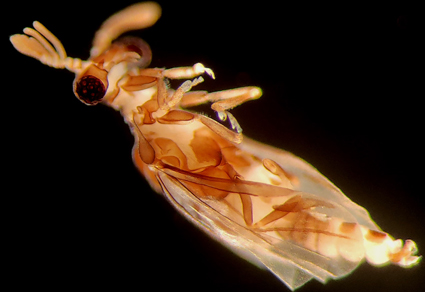Abstract
A new species of the genus Coriophagus Kinzelbach is described from the state of Jharkhand, India raising two in number from India. The new species, Coriophagus chaudhuri differs from other members of the genus in wing venation with base of R3 touching the subapex of R4, and flattened, oval-shaped foretarsomere I. The DNA barcoding of the new species has also been attempted here. An attempt is made to hypothesise the possible phylogenetic relationship of the males of the genus. A world key to known males of the genus is provided.
References
- Ashe, P. & O'Connor, J.P. (2009) A world catalogue of Chironomidae (Diptera), Part 1: Buchonomyiinae, Chilenomyiinae, Podonominae, Aphroteniinae, Tanypodinae, Usambaromyiinae, Diamesinae, Prodiamesinae and Telmatogetoninae. Irish Biogeographical Society & National Museum of Ireland, Dublin, 445 pp.
- Bohart, R.M. (1962) A new species of Strepsiptera parasitic on Coreidae. Proceedings of the Entomological Society of Washington, 64, 91–94.
- Cook, J.L. (2019) Two new species of Halictophagidae (Strepsiptera) from Costa Rica, with a discussion of differences between the genera Halictophagus and Coriophagus. Proceedings of the Entomological Society of Washington, 121 (4), 568–579. https://doi.org/10.4289/0013-8797.121.4.568
- Cowley, D.R. (1984) Coriophagus causi sp. n. (Halictophagidae: Coriophaginae): a male strepsipteran from Auckland, New Zealand. New Zealand Journal of Zoology, 11, 351–353. https://doi.org/10.1080/03014223.1984.10428250
- Folmer, O., Black, M., Hoeh, W., Lutz, R. & Vrijenhoek, R. (1994) DNA primers for amplification of mitochondrial cytochrome c oxidase subunit I from diverse metazoan invertebrates. Molecular Marine Biology and Biotechnology, 3, 294–299.
- Goloboff, P. & Catalano, S. (2016). TNT version 1.5, including a full implementation of phylogenetic morphometrics. Cladistics, 32, 221–238. https://doi.org/10.1111/cla.12160
- Harrup, L.E. (2018) The Pirbright Institute DNA Barcoding Protocols Version 3. https://doi.org/10.13140/RG.2.2.14879.41129
- Hebert, P.D., Cywinska, A., Ball, S.L. & deWaard, J.R. (2003) Biological identifications through DNA barcodes. Proceedings of the Royal Society B: Biological Sciences, 270, 313–321. https://doi.org/10.1098/rspb.2002.2218
- Hui, P., Mukherjee, B. & Hazra, N. (2023) A new species of the genus Tridactylophagus Subramaniam, 1932 from West Bengal, India with a tentative phylogeny and world key to known males (Strepsiptera: Halictophagidae). Zootaxa, 5230 (3), 296–304. https://doi.org/10.11646/zootaxa.5230.3.2
- Kathirithamby, J. (1989) Review of the order Strepsiptera. Systematic Entomology, 14, 41–92. https://doi.org/10.1111/j.1365-3113.1989.tb00265.x
- Kathirithamby, J. (1992) Descriptions and biological notes of Halictophagidae (Strepsiptera) from Australia, with a checklist of the world genera and species. Invertebrate Taxonomy, 6, 159–196. https://doi.org/10.1071/IT9920159
- Kathirithamby, J. (1993) Descriptions of Strepsiptera (Insecta) from Southeast Asia, with a checklist of the genera and species occurring in the region. Raffles Bulletin of Zoology, 41, 173–201.
- Kathirithamby, J. (2023) Catalogue of life. Available from: http://rameau.snv.jussieu.fr/cgi-bin/strepsiptera.pl (accessed 4 September 2023)
- Kifune, T. & Hirashima, Y. (1989) Taxonomic studies on the Strepsiptera in the collection of the Bishop Museum (Notulae–Strepsipterologicae–XX). Esakia, 28, 11–48. https://doi.org/10.5109/2513
- Kinzelbach, R.K. (1971) Morphologische Befunde an Fächerfläglern und ihre phylogenetische Bedeutung (Insecta, Strepsiptera). Zoologica, Stuttgart, 119, 256.
- Kogan, M. (2012) Two new species of Halictophagidae (Insecta: Strepsiptera) from the Brazilian Amazon Basin. Zootaxa, 3517 (1), 79–87. https://doi.org/10.11646/zootaxa.3517.1.5
- Luna de Carvalho, E. (1972a) Quarta contribuição para estudo dos Estrepsípteros angolensis (Insecta: Strepsiptera). Publicaçõs Culturais da Companhia de Diamantesde Angola, 84, 109–150.
- Luna de Carvalho, E. (1972b) A first contribution to the study of the Strepsiptera from Nigeria. Entomological Society of Nigeria Publication, 9, 1–18.
- Maddison, W.P. (1993) Missing data versus missing characters in phylogenetic analysis. Systematic Biology, 42, 576–581. https://doi.org/10.1093/sysbio/42.4.576
- Maddison, W.P. & Maddison, D.R. (2017) Mesquite: a modular system for evolutionary analysis. Version 3.2. Available from: http://mesquiteproject.org (accessed 4 September 2023)
- Nixon, K.C. (1999–2002) WinClada. Version 1.0000. Published by the author, Ithaca, New York. [program]
- Pohl, H. & Beutel, R.G. (2005) The phylogeny of Strepsiptera (Hexapoda). Cladistics, 21, 328–374. https://doi.org/10.1111/j.1096-0031.2005.00074.x
- Wirth, W.W. & Marston, N. (1968) A method for mounting small insect on microscope slides in Canada balsam. Annals of the Entomological Society of America, 61, 783–784. https://doi.org/10.1093/aesa/61.3.783


